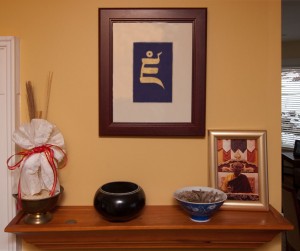Monday
Dharma TeachingsVidyadhara on Shambhala Households
This is a highlight from the Q&A between a student and Chogyam Trungpa that ocurred on August 20, 1979 at Naropa Institute, during the talk titled “Warrior of Shambhala.”Q. How would you describe the Shambhala household?
VCTR: Well, very simple. Good household washes every dish and doesn’t soak them, waiting for somebody else to clean-up after you. After your meals, wash them right away. Clean after you each time, so you don’t have to resort to your servants or somebody else to clean up after you. Take consideration of others who are taking part in the household. Be gracious to them. If they have laziness, tell them directly that you have to clean up after them as well. That’s it, pretty much, actually.
It’s a question of cleaning up and having decent mutual possibilities. I suppose Americans invented the dishwasher, because you can blame a third element which doesn’t have any mind, but is purely electric and machinery. We are going opposite of that situation. When you talk to somebody to wash up after you and they say: “I’m going to wash, but I’m soaking them in the sink.” That soaking goes on for a long time, and finally the person who is actually the grandmamma, or somebody who is actually concerned about the household, has to wash that particular dish, so-called ‘soaking’, which is just pure hype. So the idea is to clean up after yourself and have it dignified that way. It’s as simple as that, very ordinary. It’s very household level.
Shambhala vision is household level. How to take care of shining your shoes, cleaning your socks or underpants, whatever comes up, and do them methodically on the spot. You don’t send everything to the dry-cleaner, so therefore your laundry bill doesn’t become too high, which is worse. After each situation, you use a spoon to eat, you clean it. It’s very basic, very elementary. You can do that. Actually that probably would raise the consciousness of the whole nation. If everybody’s doing that in one sitting, can you imagine? There’s no hassle, and everybody’s taking care of themselves so you don’t have to blame on somebody else. It begins to become a real good thing. The only thing that we have achieved so far is that people take their own showers and bath, because nobody will do it for them. But we can do more than that. That’s Shambhala household is being very decent and being very good.
In the Japanese tradition that developed already, if you watch tea ceremony, the tea ceremony is not only concerned about serving tea alone, but cleaning after the teapot and the tea bowl and cleaning up and rinsing everything. It’s the same in the traditional monastic discipline of oryoki principle, learning how to eat and how to handle yourself properly, and how to rinse properly. So that’s idea of how to handle your household.
Whatever you began, you should also appreciate when you finish your project. That seems to be the basic point of a Shambhala household situation. Very domestic, very ordinary in that sense, but it’s very good. Then you begin to realize you have a world of your own which is a good one, and a world that is very considerate of the whole thing altogether.






Apr 5, 2010
Reply
This teaching I’ve most learned from Marcia Shibata. She teaches Kado here in L.A. twice a year, and part of the pratice includes the cleaning and care of our cutters and dismantling the flower arrangement and properly cutting it up for the compost. It’s so practical and profound, yet there is still such a strong tendency to just leave it for “later” or think of the clean up as a hassle. The fact that it is integral to the whole path helps me to apply it….most of the time!